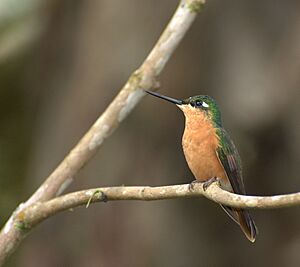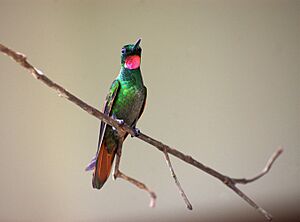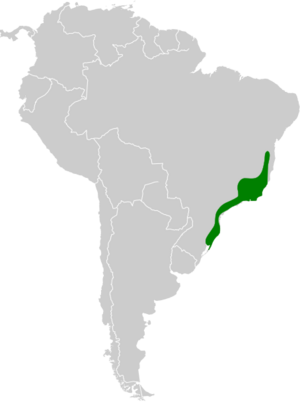Brazilian ruby facts for kids
Quick facts for kids Brazilian ruby |
|
|---|---|
 |
|
| female | |
 |
|
| male | |
| Conservation status | |
| Scientific classification | |
| Genus: |
Heliodoxa
|
| Species: |
rubricauda
|
 |
|
| Synonyms | |
|
Clytolaema rubricauda (Gould, 1853) |
|
The Brazilian ruby (Heliodoxa rubricauda) is a beautiful hummingbird found only in Brazil. It's known for its bright colors, especially the male's sparkling ruby-red throat. These tiny birds are part of a group called "brilliants."
Contents
What is the Brazilian Ruby?
The Brazilian ruby is a type of hummingbird. It belongs to a group called "brilliants" within the hummingbird family. This bird is endemic to Brazil, meaning it lives naturally only in that country.
How Did the Brazilian Ruby Get Its Name?
A French scientist named Georges-Louis Leclerc, Comte de Buffon first described this bird in 1780. Later, in 1783, a Dutch naturalist named Pieter Boddaert gave it its first scientific name, Trochilus rubicauda. The name rubricauda comes from Latin words meaning "red tail."
For a long time, this hummingbird was in its own genus (a group of closely related species) called Clytolaema. This name means "glorious throat" in Ancient Greek. But in 2014, new studies showed it actually fits better in the Heliodoxa genus. So, its scientific name changed to Heliodoxa rubricauda.
Is There Only One Type of Brazilian Ruby?
Yes, the Brazilian ruby is a monotypic species. This means there are no different subspecies or types of Brazilian ruby hummingbirds.
What Does the Brazilian Ruby Look Like?
The Brazilian ruby is a small bird, about 10.8 to 11.3 centimeters (4.3 to 4.4 inches) long. Males are a bit heavier than females. Both have a medium-sized black beak and a white spot behind their eyes.
Male Brazilian Ruby Appearance
Adult males are very colorful. They have a shiny emerald green forehead and crown (top of the head). Their back is golden bronze. The chin is dark, and the throat has a bright, shining ruby-red patch. This patch is called a gorget. Their chest is iridescent emerald green, and their belly is dark gray with green spots. The central tail feathers are golden bronze, and the outer ones are reddish-brown with bronze edges.
Female Brazilian Ruby Appearance
Adult females are also pretty but less flashy than males. They have a grass-green crown and back. Their rump (lower back) is cinnamon-colored. Their entire underside is cinnamon. Their tail looks similar to the male's.
Young Brazilian Ruby Appearance
Young Brazilian rubies look like females. They also have soft, buff-colored fringes on their head feathers. Sometimes, you might see a melanistic (all black) Brazilian ruby, which is a natural color variation.
Where Does the Brazilian Ruby Live?
The Brazilian ruby lives in eastern and southeastern Brazil. You can find it from the state of Bahia south to Rio Grande do Sul.
What Kind of Places Do They Like?
These hummingbirds live inside forests, in scrublands, and even in parks and banana plantations. They are often seen visiting bird feeders in gardens. They are most common below 500 meters (1,600 feet) in elevation. However, they can live as high as 1,500 meters (4,900 feet).
How Does the Brazilian Ruby Behave?
How Do They Move Around?
Brazilian rubies usually stay in one area. But they might move to different elevations during certain seasons.
What Do They Eat?
The Brazilian ruby mainly feeds on nectar from many different kinds of flowering plants and trees. They visit both native plants and those brought in by people. Male hummingbirds often protect their favorite feeding spots. Females sometimes do this too. They also catch small insects by hawking, which means they fly out from a perch to snatch insects in the air.
How Do They Raise Their Young?
The breeding season for the Brazilian ruby is from November to March. The female builds a cup-shaped nest using soft plant materials. She decorates the outside with lichen. The nest is usually placed on a horizontal branch, about 3 to 10 meters (10 to 33 feet) above the ground.
The female lays two eggs and sits on them for about 15 to 16 days. The young birds leave the nest about 25 days after they hatch.
What Do They Sound Like?
The Brazilian ruby's song sounds like "jig chrrrrrr....jig cherrrrrr...jig chrrrrrr". They also make a "jig jig jig" call.
Is the Brazilian Ruby in Danger?
The IUCN (International Union for Conservation of Nature) has listed the Brazilian ruby as a species of "Least Concern." This means they are not currently considered to be in danger of extinction.
Even though we don't know the exact number of these birds or if their population is growing or shrinking, there are no immediate threats to them. They live in many protected areas. They are also quite common throughout their range and can live well in places changed by humans, like gardens, parks, and plantations.


